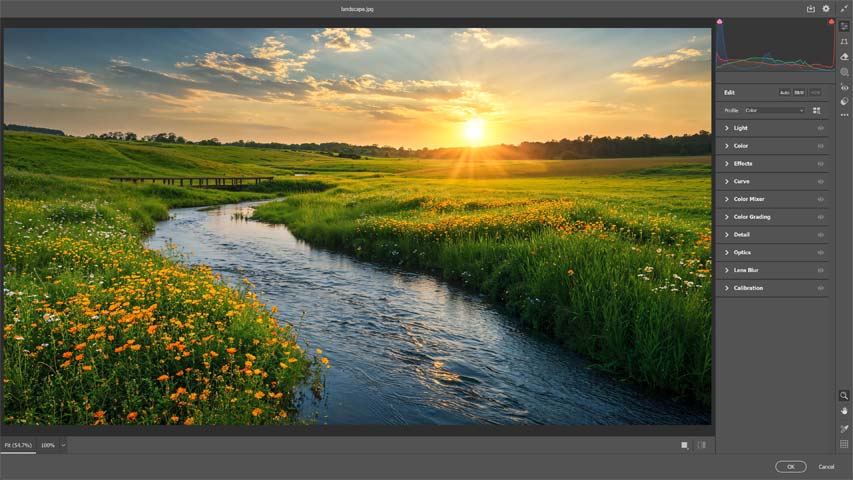
The Smart Way to Use Photoshop’s Camera Raw Filter
Photoshop's Camera Raw filter is like having Lightroom's Develop module directly in Photoshop. But there's a trick you need to know to keep your Camera Raw edits non-destructive.

Download the PDF: The Smart Way to use the Camera Raw Filter
Photoshop’s Camera Raw filter is the best way to edit your images in Photoshop.
That’s because the Camera Raw filter lets you ignore many of Photoshop’s outdated and old school ways of doing things and instead gives you a modern editing environment with the same intuitive image editing controls found in Lightroom’s Develop module.
Everything from Lightroom’s lighting and color corrections to its powerful masking features, and even its new AI features like Lens Blur and AI Remove, are all found in Photoshop’s Camera Raw filter. In fact, the Camera Raw filter and Lightroom share the same engine behind the scenes, so the Camera Raw filter really is like having Lightroom directly inside Photoshop. And that is a very good thing.
But there’s a right way and a wrong way to use the Camera Raw filter.
The wrong way is to apply it directly to your image. One of the main benefits to using Lightroom is that all of your edits are non-destructive so you can go back and make changes when needed. But when you apply the Camera Raw filter directly to your image in Photoshop, your edits become permanent and you lose that non-destructive workflow.
The right way to apply the Camera Raw filter is to apply it as a smart filter. Smart filters are just like regular filters but they are completely non-destructive, so you can always go back and edit a smart filter’s settings without making any permanent changes. By applying Camera Raw as a smart filter, not only do you have the same editing features as Lightroom but also the same non-destructive freedom. So here’s how to apply Camera Raw as a smart filter.
Which Photoshop version do I need?
To access all of Camera Raw's new features, you will need a Creative Cloud subscription so you can update Photoshop and Camera Raw to the latest version.
Let's get started!
Step 1: Open your image in Photoshop
Start by opening your image in Photoshop. I’ll use this jpeg image.
The Camera Raw filter works with any image you’ve opened in Photoshop so you don’t need to worry about file compatibility.

Step 2: Convert the image layer into a smart object
In the Layers panel, the image is on the Background layer.

To apply the Camera Raw filter as a smart filter, we first need to convert our image layer into a smart object.
The fastest way to convert a layer to a smart object is to right-click on it and choose Convert to Smart Object from the menu.

The Background layer’s name will change to Layer 0 and you’ll see a smart object icon in the lower right of the thumbnail.

Step 3: Open the Camera Raw filter
With our image layer now a smart object, Photoshop will automatically convert the Camera Raw filter to a non-destructive smart filter when we apply it. It’s that simple.
Go up to the Filter menu in the Menu Bar along the top of the screen and choose Camera Raw Filter.

Your image will open inside the Camera Raw filter’s dialog box. If the dialog box does not fill the entire screen, press F on your keyboard to switch to full screen view.
The Camera Raw filter’s dialog box shows your image in the large preview area, with all of the editing controls divided into panels along the right.

Step 4: Edit your image in Camera Raw
Since Camera Raw is an entire image editing environment, there’s far too much you can do with it to cover in a single tutorial.
But one thing you can do very easily is convert your image to black and white. Simply click the B&W (for Black and White) button directly below the histogram in the upper right corner.

Camera Raw instantly converts your color image to black and white using its default settings.

You can then twirl open the B&W Mixer panel in the right hand column and click the Auto button to let Camera Raw analyze the image and give you a better result.

Here’s the black and white conversion the Auto feature came up with.
There are ways to adjust it even further but since that’s not the focus of this tutorial, I’ll just accept it.

Step 5: Close the Camera Raw filter
When you’re done editing your image, click the OK button in the lower right of the dialog box to commit your changes and close the Camera Raw filter.

Back in Photoshop’s main interface, my image now appears in black and white.
If we had applied the Camera Raw filter directly to the image, it would now be permanently in black and white. But because we applied it as a smart filter, the edit was non-destructive.

Notice in the Layers panel that the Camera Raw filter is listed as a smart filter below the image. You can toggle the Camera Raw filter on and off by clicking the eyeball icon to the left of its name. This lets you view your image before and after your Camera Raw settings are applied.
Step 6: Edit the Camera Raw Filter settings
To reopen the Camera Raw filter and make changes, simply double-click on the filter’s name.

The image reopens inside the Camera Raw filter dialog box with all of your previous settings intact.
In my case, I didn’t really want to convert the image to black and white. So to switch back to the full color version, all I need to do is click once again on the B&W button below the histogram.

Camera Raw instantly restores the color.

I’ll click OK once again to close the Camera Raw filter dialog box.
Back in Photoshop’s main interface, the full color image returns, all thanks to the fact that we applied the Camera Raw filter as a non-destructive smart filter.

And there we have it! That’s the right way (and the smart
way) to edit images with the Camera Raw filter in Photoshop.
Related tutorials:
- Using the new Generate Background AI in Photoshop
- How to brighten eyes and make them sparkle
- Image adjustments vs adjustment layers in Photoshop
Don't forget, all of my Photoshop tutorials are now available to download as PDFs!